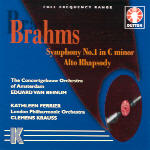Eduard van Beinum’s recorded legacy is probably less appreciated at present than it should be, due in part to its general unavailability worldwide, but also to the kind of conductor that he was. When listening to historical recordings, with their often limited dynamic range and sometimes-questionable provenance, it’s easier to extol the virtues of artists like Furtwängler and Mengelberg (Beinum’s predecessor) who made their interpretive points generally through heavily interventionist tactics typified by extreme fluctuations of tempo. After all, in many historical recordings, tempo is just about the only thing you can hear. Like his colleagues Erich Kleiber, Otto Klemperer, and his successor Bernard Haitink, Beinum did not indulge in rhetorical excess on the podium or draw attention to his “interpretation” as something imposed on the music from without. He made his points through the finer details of orchestral playing: balance, rhythm, color, accent, and articulation. His (generally swift and steady) tempos were a function of these other qualities. For this reason, good recorded sound is critical to an appreciation of his work. The more you can hear, the more convincing his interpretation becomes.
This recording of Brahms’ First Symphony is a case in point. Dating from 1947, it’s a good, clean performance in a quick, Toscanini-like style apparently without much distinctive personality. Turn to his 1958 stereo remake, though (available as an import on Philips’ Dutch Masters series), and we’re in a different world. Now the opening has depth, the bell-like tones of the timpani (so weak in 1947) effortlessly supporting the broad singing lines in the strings and winds. The first movement’s development section has far greater trenchancy, with its sharper rhythmic profile and long-lined melodic exchanges between orchestral sections. Beinum also finds a luminous quality to the second and third movements missing in his earlier rendering. He’s exquisitely sensitive to Brahms’ dynamics, a fact only hinted at by the earlier recording’s more limited range and less sophisticated balances. Listen, for example, to the delicate way in 1958 that he “touches in” the clarinet counterpoint in the second presentation of the third movement’s principal theme. It’s louder in 1947, yes, but wrongly so (Brahms marks it piano and “dolce” against the mezzo-piano in the violins), and there’s also far less prominence given to the wonderful pizzicato accompaniment, which in the later performance becomes a genuine countermelody, a swift current that binds together the lazier thematic ideas floating on its surface. In the 1958 finale, the rich-textured strings really sing out the principal theme, while previously a somewhat perfunctory coda now positively glows with effortless majesty.
The point here is not that this 1947 performance is bad, but rather that in the game of comparisons that is classical record collecting, it seems pointless to recommend a version of a work that represents the musicians involved at anything less than their very best, either artistically or technically, especially given the fact that the 1958 remake really is one of the finest interpretations of the work in question. Beinum was a great Brahms conductor, make no mistake, but those qualities that made his performances special, and which I have touched on above, are only fitfully audible on this Dutton release, however well transferred or ahead of its time the sound may be. As for the couplings, Clemens Krauss directs a lively Academic Festival Overture, while Kathleen Ferrier’s Alto Rhapsody is atrocious, richly justifying her claim to being the most overrated singer in recorded history. She’s much too closely balanced, her tone sounds at once thick and hollow, her diction is mannered, and her dynamic shading non-existent, all of which makes her unconvincingly stylized delivery of the text painfully unappealing. Krauss’ accompaniment is as efficiently uninspired as the choir is mediocre–compared to great performances such as Ludwig/Klemperer this shabby mess is a non-starter.
To summarize: If you can find Beinum’s complete Brahms cycle on Philips (here’s a source: http://www.kuijperklassiek.nl), grab it while you can. It’s one of the best, and very inexpensive. This performance likely will not convert you to Beinum’s cause, and the couplings don’t make any special claim on your purse either.
































